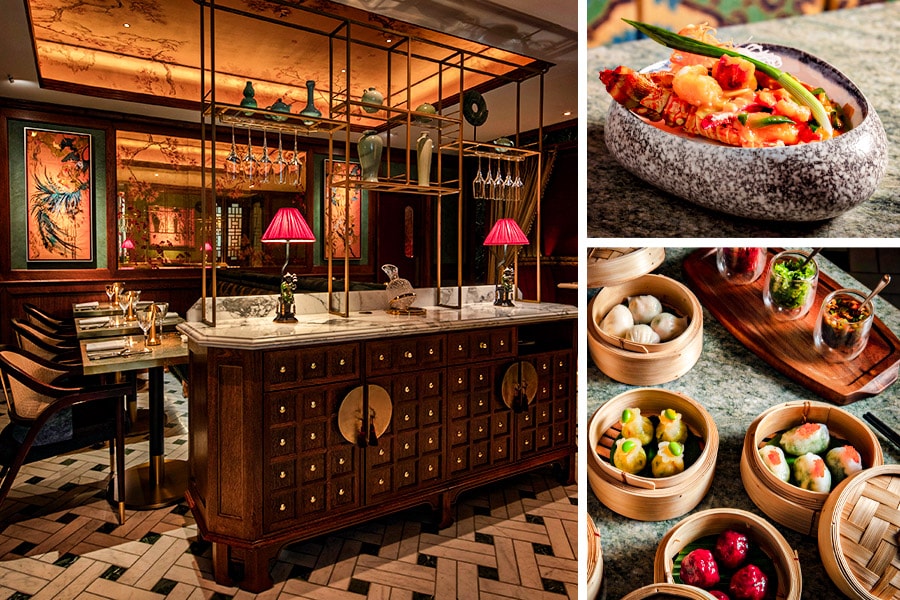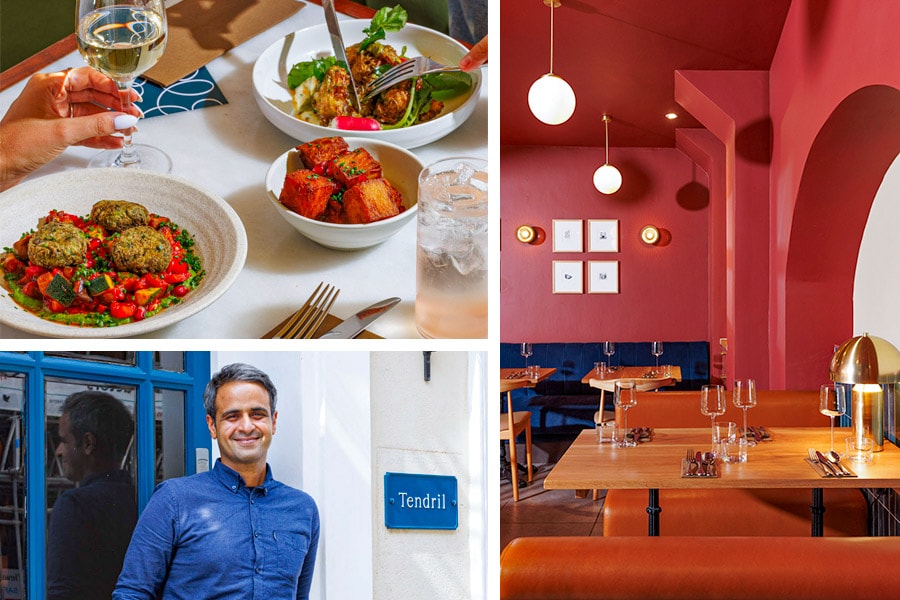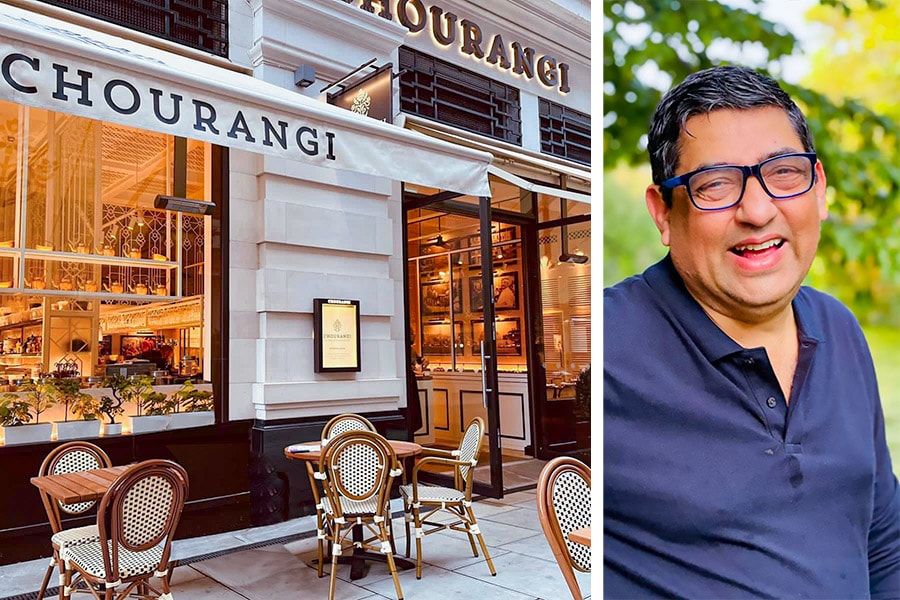How London's turning into a playground for Indian F&B
Some of London's biggest and poshest restaurant and hospitality ventures post pandemic reflect the growing clout of Indian restaurateurs and the splurging power of the Indian diner


The high gilded ceiling is stunning with its fine mosaic work, arched marble walls glisten with inlays of semi-precious stones—turquoise, jade, mother of pearl. And then there is the long bar—sleek, LED-lit, luminous like a quartz, a modern addition to this old space, where we sit at a communal table sipping saffron and black pepper negroni, elaichi sour, and chai cocktails.
We are at the sprawling new Masala Zone, central London’s hottest restaurant launch this summer, facing Piccadilly Circus. On the menu is jalebi chaat, and keema pao sliders, gentrified onion bhajiya shaped like a flower, street snacks and home style gravies with recipes sourced from gourmet subcontinental homes—“real Indian" served, ironically, in a building, which once connoted the opulence and might of the British Empire, but is now a striking showcase for India and Indian food.
When it opened in 1873, the Criterion was a luxurious restaurant complex, with its bar a society favourite, routinely mentioned in literary tomes, right from HG Wells’ to Conan Doyle’s. In the first Sherlock Holmes book, A Study In Scarlet, for instance, Dr Watson meets a friend at the Criterion, who first tells him about his future roommate.
The high teas, too, became favoured with ladies who shopped at West End, so the restaurant hosted Britain’s first suffrage meeting in 1909—a time, when India was under colonial rule, the Minto Morley reforms (giving limited elected representation to Indians in their own governance) had barely been introduced, and Gandhi was as yet in South Africa, just beginning his experiments with truth…
In short, the Criterion is a historic landmark.
It has also been a graveyard for restaurants in the last few decades high-profile European ones—French, Italian, even Marco Pierre White’s—given its long, cavernous interiors that are protected and hence cannot be tampered with even if they sit uneasily with the language of modern global food.
Yet, “it was the most coveted restaurant site in central London, so many restaurant companies wanted to open here," veteran restaurateur Ranjit Mathrani tells me. Mathrani, along with his wife Namita and sister-in-law Camellia, co-owns MW Eat, the company that runs some of London’s most iconic Indian restaurants such as the stylish Michelin-starred Amaya, Chutney Mary, a haunt of British premiers (“Any British prime minister who does not dine here, does not last," jokes Mathrani), and Veeraswamy, at the site of the oldest Indian restaurant abroad.
The pathbreaking trio, amongst London’s most recognised Indians for close to three decades, took up the prestigious Criterion complex to open a sprawling 150-cover Masala Zone, a casual diner serving nashtas and wholesomeness, at modest price points of around GBP 20-30 per person, undaunted by its reputation. “We decided on this site, like the current Chutney Mary, where too many others had failed, because we analyse deeply why others have failed, and tailor both interior design and food quality and price of our offering accordingly," says Camellia Panjabi.
The Victorian opulence of the Criterion, and the maximalism inherent in Indian food do go well, and accenting the Indian-ness are marble jaalis, antiques and specially commissioned art works collected by the owners over the years—so that you may think you are dining in a princely 19th century Indian home rather than Piccadilly.
It’s a neat overturning of the colonial construct.
If the new Masala Zone is a marquee London opening this year, showcasing Indian food and Indian entrepreneurship at its best, some of central London’s biggest restaurant and hospitality ventures post pandemic are all equally emblematic of Indian entreprenuers’ growing visibility and clout even in a city that has historically seen many Indian business families make a mark.
But in an economy battered by a cost-of-living crisis, where big ticket investments have been fewer, splashy restaurant and hotel openings by Indian-owned companies or Indian-origin entrepreneurs are in the spotlight, especially since so many of them deftly, if unconsciously, flip the colonial past. The irony is nowhere more evident than in the impending opening of the new Raffles at the Old War Office, another landmark heritage address, where Winston Churchill once sat and strategized—by the Hinduja Group.
With 120 rooms and as many as 11 destination restaurants and bars, this is likely to be London’s most vaunted address for luxury dining when it opens this autumn. The renovation and restoration of the building had been taken up by the Hinduja group since acquiring its lease in 2016. According to the New York Times, the Ministry of Defence sold a 250-year lease for £350 million, and more than a billion pounds of private investment have been since poured into the work.
 The Taj has just opened its Chinese restaurant brand House of Ming, an off-shoot of the popular New Delhi eatery, in another big-ticket summer launch with “a substantial investment".
The Taj has just opened its Chinese restaurant brand House of Ming, an off-shoot of the popular New Delhi eatery, in another big-ticket summer launch with “a substantial investment".
There are others. The Taj has just opened its Chinese restaurant brand House of Ming, an off-shoot of the popular New Delhi eatery, in another big-ticket summer launch with “a substantial investment". The food is untrammelled by the chilli-garlic of Indian-Chinese, and high-quality ingredients such as whole halibut or prawns cooked with just ginger and scallion, or roast pork are cooked in minimalistic, classic ways. “We are getting a mix of both Indian and non-Indian clientele. Since we are in London, it is important to keep the quality of ingredients and cooking high and we want to compete with top Chinese restaurants here," points out chef Sujoy Gupta.
This appetite to establish oneself as the best in a competitive global arena outshining competition is, in fact, a new ambition even if older restaurant and hotel companies by Indians had been uber successful, too, in their own spaces.
Samyukta Nair, of the Leela family, is an example of this new ambition to not just redefine Indian dining, but all sorts of dining in the heart of Mayfair, London’s toniest. Since she moved here fully in 2021 (after living between India and the UK for a while before), she has been on an envy-inducing expansion spree, opening three of Mayfair’s most talked about luxury projects. None of them is Indian (though her company does have Jamavar and Bombay Bustle in its portfolio too).
 The chinese restaurant Mimi Mei Fair at the tony Mayfair, London is among a bunch of bespoke culinary concepts by the daughter father duo Samyukta and Dinesh Nair
The chinese restaurant Mimi Mei Fair at the tony Mayfair, London is among a bunch of bespoke culinary concepts by the daughter father duo Samyukta and Dinesh Nair
Mimi Mei Fair, a Chinese restaurant, Koyn, a contemporary Izakaya, and Socca, a French-Mediterranean bistro with the celebrated chef Claud Bosi, have all opened in the last one-and-half years, making Nair one of the most promising restaurateurs to watch out for in London. “Personally, it’s been a big year for me as I was awarded the best restaurateur by the British GQ and Restaurateur of the year by the National restaurant awards," she says, intent on taking her family legacy of luxury hospitality forward. Along with her father Dinesh Nair, Samyukta owns LSL Capital that has been making these big-ticket investments, because she felt “Mayfair specially lacking in new and interesting culinary concepts lately", having been well versed with the area after studying and living in London. “With our portfolio, the endeavour is to create the Mayfair we as a family want to visit," she says, and compares the tony neighbourhood to an older Bombay in the way it is laid out.
Nair is, of course, not the first Indian restaurateur to have created ambitious luxury restaurants not necessarily focussed on desi food. The soft-spoken octogenarian Arjun Waney has a slew of fashionable restaurants such as Roca and Zuma, La Petite Maison, Coya and the members-only The Arts Club, where you may rub shoulders with British royalty or Hollywood high rollers including Gwyneth Paltrow, who is a partner. There is also the JKS group with its trendy restaurants, many in collaboration with chefs and creators who may be Londoners but not Indian. And there are mavericks like chef Rishim Sachdeva, who used to head the Olive in Mumbai but moved back to London, his hometown, to create a global (mostly) vegan restaurant.
Tendril has just opened in Mayfair too, a pandemic baby, graduating from being a pop-up to a trendy new addition to a swish foodscape. It is cuisine agnostic and though Sachdeva says he had to battle many stereotypes about being an Indian chef doing non-Indian food internationally, he found many backers, too, from amongst his patrons (and some crowd funding) to be able to roll out his new, courageous venture.
Also read: What"s cooking with Manu Chandra?

The maverick chef Rishim Sachdeva moved back to London, his hometown, to open a global (mostly) vegan restaurant Tendril in Mayfair
If there seems to be new ambition to create the best, luxe, marquee restaurants and hotels amongst Indian companies, the diners seem to have also come of age. While central London that has always been a playground for rich Emiratis, Russian oligarchs, high spending American and European tourists, as also Indian business families, post pandemic, some of the new consumers of its luxuries include Indians who are not just London residents or part of its workforce but high spending Indian and NRI tourists, and long stayers who have bought homes in the poshest areas.
According to a luxury outlook report published by Sotheby’s last year, ultra high networth Indians were amongst the highest buyers of real estate in London—riding on a rise in personal wealth and aspiration for this section of Indians, even as other parts of the world see socio-economic and political crises.
Many of these consumers have children studying in the UK, a segment that is also booming. Indian students in the UK have seen a massive 273 percent hike post pandemic, overtaking China in sending the maximum number to British varsities. London is naturally the playground for these families, who, anecdotally at least, are at the forefront of consumption in an otherwise debilitated economy.
 Restauranteur Anjan Chatterjee"s Chourangi is running full houses most evenings with its spot-on flavours—the kosha mangsho, Calcutta cutlets and malai curry.
Restauranteur Anjan Chatterjee"s Chourangi is running full houses most evenings with its spot-on flavours—the kosha mangsho, Calcutta cutlets and malai curry.
“While the corporate crowd has still not come back fully to pre-pandemic levels, it is to some extent being made up by high-spending tourists and by people who have bought homes in the areas around. We get many people from the fields of entertainment and sports, for instance, who tell us they stay nearby," says chef Sameer Taneja of Benares, the top-rated Mayfair restaurant.
At Masala Zone, Camellia Panjabi, too, is surprised at how more Indians have been coming in. “Unexpectedly, Indians, including locals, tourists, and Indians from all over the world are making up half of our customers at the moment," she says. Panjabi had often told me in the past about how “Indians don’t value Indian food, and they may take the mother-in-law to an Indian restaurant, but not their boss".
Now, that may be changing. If Indian entrepreneurs are upping the ante on luxury F&B, regional and “real" Indian food, too, has got a fillip in the post pandemic world with booming travel and people seeking cultural authenticity more.
The day I visit Masala Zone, it is full of not just families but also business leaders. Pankaj Khimji, director of the illustrious Khimji Ramdas Group and chairman of Oman Cricket, who, this year, was appointed as Oman’s foreign trade advisor, has been dining with a delegation, and comes over to say a quick hello to the family. It’s his second visit to the newly opened restaurant ostensibly.
“We are getting many business leaders or CEOs from India and countries with deep ties to it, who want authentic flavours and also want to showcase this heritage to their colleagues and peers," notes Anjan Chatterjee, the legendary Bengali restaurateur who opened Chourangi at Marble Arch in 2021. With its spot-on flavours—the kosha mangsho, Calcutta cutlets, malai curry et al—Chourangi is running full houses most evenings, peopled with not just locals and many non-Indian Londoners who have graduated beyond Bangladeshi-run curry houses, but also visiting Indian and Indian-origin businessmen and corporates from all over the world.
“As a deeply multicultural city, London appreciates honest food," says Chatterjee, who had been looking to open a Bengali restaurant on the lines of Oh! Calcutta here for a long time, not just for prestige but because he felt the market had grown beyond chicken tikka masala. “Quality regional Indian food such as what chef Sriram Aylur does (at the Taj’s Quillon, serving coastal south Indian) who I admire, was doing well," he points out.
So, he took the plunge along with business partner Aditya Ghosh, also co-founder of Akasa Air. The high investments and high labour costs notwithstanding—an 85-cover restaurant like this takes approximately £1.5 million (or Rs 20 crore), in capital investment, while in India, a similar one can be set up for less than half—Chatterjee is clear that the potential returns once the restaurant matures will be higher too.
London after all is a “Richie rich" city. And now, Indian hospitality is making it its own.
First Published: Aug 14, 2023, 11:04
Subscribe Now